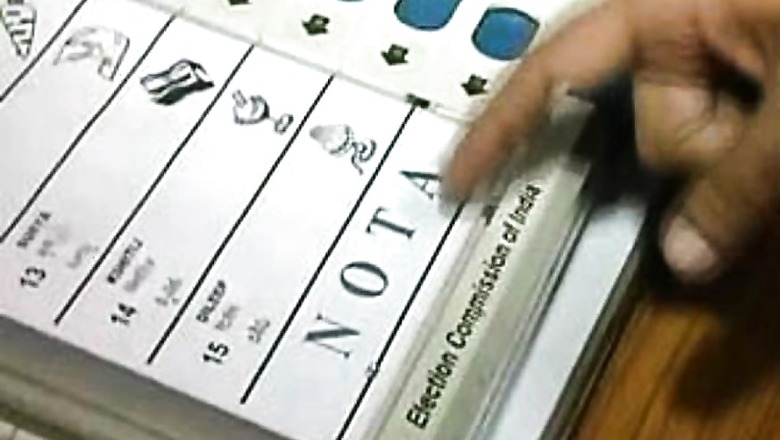
views
New Delhi: The None of the Above (NOTA) option enables the voter to not vote for any of the candidates contesting the elections. As NOTA does not guarantee the dismissal of a winning candidate, it is only a method to give a negative feedback.
In the recent Assembly polls in Gujarat (2017), Karnataka (2018) Madhya Pradesh (2018) and Rajasthan (2018), NOTA seemed to be a popular option among many voters.
Ahead of Lok Sabha polls, News18 explains to you what NOTA is and how it operates.
What is NOTA?
NOTA is an option exercised by a voter to specify that he does not have confidence on any of the contesting candidates or the parties in fray.
It was in January 2014 that the Election Commission of India issued a circular stating that the provisions of NOTA should also be included in the Rajya Sabha elections as the provision was made available in the Electronic Voting Machine (EVM) in 2013.
Did this Have Root in Apex Court?
The Supreme Court had upheld the right of voters to reject all candidates contesting the elections, saying it would go a long way in cleansing the political system of the country. The apex court directed the Election Commission to have NOTA option on the EVMs and ballot papers in a major electoral reform.
How Does One Cast a NOTA Vote?
The EVMs have the NOTA option at the end of the candidates' list. Earlier, in order to cast a negative ballot, a voter had to inform the presiding officer at the polling booth. Now, a NOTA vote doesn't require the involvement of the presiding officer.
When was NOTA First Used in India?
The NOTA option was first used in the Assembly elections held in four states -- Chhattisgarh, Mizoram, Rajasthan and Madhya Pradesh and the Union Territory, Delhi in 2013. More than 15 lakh people exercised the option in the state polls. 3.56 lakh in Chhattisgarh; 5.9 lakh in Madhya Pradesh and 5.67 lakh in Rajasthan.
What was NOTA Preceded by?
Before the NOTA was introduced, candidate had a right to reject all candidates but could not register it on the EVM machine. Then, people casting negative votes were required to enter their names in a register and cast their vote on a separate paper ballot.
It was under Section 49 (O) of the Conduct of Elections Rules, 1961, a voter could enter his electoral serial number in Form 17A and cast a negative vote. The presiding officer would then put a remark in the form and get it signed by the voter. This was done to prevent fraud or misuse of votes.
This provision was, however, deemed unconstitutional by the Supreme Court as it did not protect the identity of the voter.
What was the Need of NOTA?
"Negative voting will lead to a systemic change in polls and political parties will be forced to project clean candidates. If the right to vote is a statutory right, then the right to reject a candidate is a fundamental right of speech and expression under the Constitution," said a bench headed by the then Chief Justice of India, P Sathasivam.
The bench also pointed out that the system of negative voting existed in several other countries. Even in Parliament, the MPs have the option to abstain from vote.
Is NOTA Practiced Internationally?
Colombia, Ukraine, Brazil, Bangladesh, Finland, Spain, Sweden, Chile, France, Belgium and Greece allow their voters to cast NOTA votes. The US also allows it in a few cases. The state of Texas in the US permits the provision since 1975. The option, however, has faced opposition there.
How did NOTA Fare in Last Assembly Elections?
Votes cast in favour of NOTA option were more than the margin of victory in 22 Assembly constituencies in Madhya Pradesh, the Election Commission data shows. NOTA even `outperformed' some of the parties such as the Aam Aadmi Party (AAP) and Samajwadi Party (SP), getting more votes across the state than them. As many as 5, 42,295 voters pressed the NOTA button on Electronic Voting Machines, which was 1.4 per cent of the total number of votes cast. But the number is less than that in the 2013 polls when 6.43 lakh (1.9 per cent) voters rejected all candidates.




















Comments
0 comment